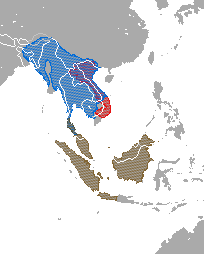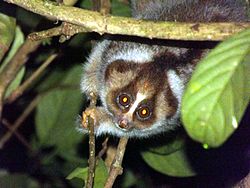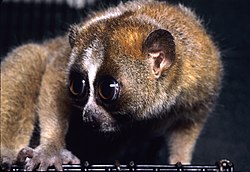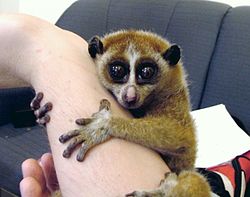Slow loris
Slow lorises are the genus Nycticebus, nocturnal species of strepsirrhine primates. They live in southeast Asia and nearby areas.
| Slow lorises | |
|---|---|

| |
| Sunda slow lorisNycticebus coucang | |
| Conservation status | |
| Scientific classification | |
| Kingdom: | Animalia |
| Phylum: | Chordata |
| Order: | Primates |
| Family: | Lorisidae |
| Subfamily: | Lorinae |
| Genus: | Nycticebus É. Geoffroy, 1812[1] |
| Type species | |
| Nycticebus coucang Boddaert, 1785
| |
| Species | |
| |

| |
| Distribution of Nycticebusred = N. pygmaeus;blue = N. bengalensis;brown = N. bancanus, N. borneanus, N. coucang, N. javanicus, N. kayan & N. menagensis | |
| Synonyms[2][3] | |
| |
There are about eight species: the Sunda slow loris (N. coucang), Bengal slow loris (N. bengalensis), pygmy slow loris (N. pygmaeus), Javan slow loris (N. javanicus), Philippine slow loris (N. menagensis), Bangka slow loris (N. bancanus), Bornean slow loris (N. borneanus), and Kayan River slow loris (N. kayan).
The group's closest relatives are the slender lorises of southern India and Sri Lanka. Their next closest relatives are the African lorisids, the pottos, false pottos, and angwantibos. They are less closely related to the remaining lorisoids (the various types of galago), and more distantly to the lemurs of Madagascar.[4] Their evolutionary history is uncertain: their fossil record is patchy and molecular clock studies have given various results.
Slow lorises eat insects, small birds and reptiles, eggs, fruits, gums, nectar and some vegetation. A 1984 study of the Sunda slow loris found its diet was 71% fruit and gums, and 29% insects and other animal prey. A more detailed study of another Sunda slow loris population in 2002 and 2003 showed different dietary proportions: 43.3% gum, 31.7% nectar, 22.5% fruit, and just 2.5% arthropods and other animal prey.[5]
Slow Loris Media
The Kayan River slow loris (N. kayan) was distinguished from N. menagensis in 2012.
The eyes of slow lorises are large and have a reflective layer, called the tapetum lucidum, to help them see better at night.
Slow lorises are popular in the exotic pet trade, which threatens wild populations.
References
- ↑ Groves 2005, pp. 122–123.
- ↑ "Table 2 b: taxonomic names and synonyms used by several authors: genus, species, subspecies, populations" (PDF). Loris and potto conservation database. www.loris-conservation.org. 4 February 2003. p. 3. Retrieved 30 April 2013.
- ↑ "Synonyms of Slow Lorises (Nycticebus)". Encyclopedia of Life. eol.org. Archived from the original on 5 December 2013. Retrieved 30 April 2013.
- ↑ Bearder, Simon K. 1987. Lorises, bushbabies, and tarsiers: diverse societies in solitary foragers. In Smuts, Barbara B. et al (eds) Primate societies. Chicago, Illinois: The University of Chicago Press. ISBN 0-226-76716-7
- ↑ Nekaris K.A.I. & Bearder S.K. 2007. Chapter 3: The lorisiform primates of Asia and mainland Africa: diversity shrouded in darkness. In Campbell, C. et al (eds) Primates in perspective. New York: Oxford University Press. ISBN 978-0-19-517133-4








